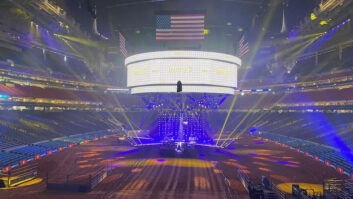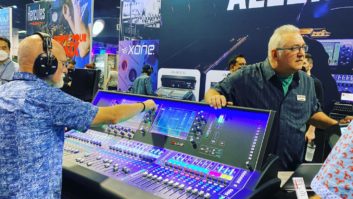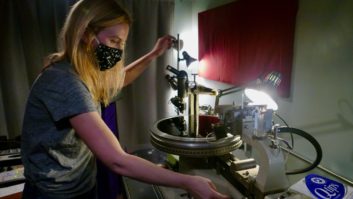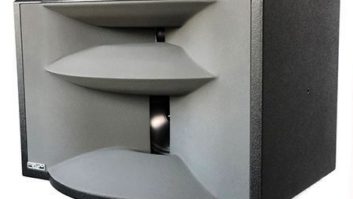The future of Consumer 3D’s so bright, I gotta wear shades…
by Mel Lambert.

In the week that James Cameron’s Avatar crested $1 billion in box office receipts, 3D delivery and playback was the prominent theme at the annual Consumer Electronics Show in Las Vegas. Samsung, Panasonic, Toshiba, Sony, JVC and even Vizio unveiled new 3D-TV receivers (some models even convert 2D content into immersive 3D), while ESPN, Fox Sports, DirecTV and Discovery Communications (in partnership with Sony and IMAX) plan to launch 3D-TV networks. And several brands will offer 3D-capable Blu-Ray players, while Panasonic introduced its first fully integrated, pro-quality 3D camcorder. Graphics-card guru Nvidia also unveiled 3D options for laptop and desktop PCs.
The first Blu-ray 3D releases are scheduled to begin shipping later this year, with several concerts and sporting events to be broadcast in 3D, including June’s FIFA World Cup soccer matches, PGA golf tournaments, college basketball and Summer X-Games, courtesy of ESPN and other content creators. According to Avatar producer Jon Landau, “3D is not about gags coming off the screen; it’s about creating a window into a world–a more immersive experience for the viewer.”
At the other end of the complexity (and affordability) spectrum, new-generation mobile phones will offer a range of innovative features. An LG offering with an add-on projector will display stored content, while current market leader Nokia plans to extend built-in functions to third-world and emerging countries via a $1 million investment for an innovation that is designed specifically to improve lives globally.
Microsoft chief executive Steve Ballmer’s keynote speech revealed that an Xbox 360 add-on will allow users to manipulate the console and play games using natural body movements and speech. “Project Natal will free you to have the experience you want with technology that’s natural for you,” offered Robbie Bach, president of Microsoft’s entertainment devices division. Ballmer identified three key aspects of Microsoft’s strategy. “First is the increasing importance and change in the screens woven into the fabric of our lives,” he said. “In particular, we want to focus on the ever-evolving PC, and the future of the TV experience. Second is the cloud–we believe in an approach that combines the power of immersive and intelligent software. Third is the next revolution in natural user interface or NUI technology.” High on the firm’s agenda is instant-on, 1080p, HD videos and an expansion of the Zune music/video service to other Microsoft platforms.
A particularly interesting technology demonstration organized by chipmaker Broadcom Corporation spotlighted the use of Audio Video Bridging to send digitized audio from a dbx Model SC32 Digital Mixer through two BSS/NetGear AVB-compliant Ethernet switches to a pair of Crown CTS600 power amplifiers. Broadcom’s Hawkeye 53314 ICs handle AVB interfacing and the generation of timing reference signals to ensure low-latency, on-demand delivery of multichannel digital audio. The recently-announced AVnu Alliance, whose membership includes Harman, Meyer and Avid, is advocating use of the IEEE 802.1 AV delivery protocol in pro-audio, consumer and automotive products.
Compression technology leaders Dolby and DTS offered their respective spins on delivery mechanisms. Dolby focused on how its Digital Plus and TrueHD technologies transform sound within a number of consumer environments, including internet-connected TVs, Blu-ray players, PCs and game consoles, in addition to showcasing the first set-top boxes and receivers to feature Dolby Volume. DTS was promoting Premium Suite for PC applications, which provides a range of options from 7.1 lossless to high quality simulated surround from stereo sources; Symmetry balances loudness levels between multimedia sources. The firm’s HD Master Audio is now being used within a number of Blu-Ray, digital cable, VoD and satellite systems.
Within the high-end audio exhibits at The Venetian, several firms were showing interesting wares. Ocean Way’s Alan Sides demonstrated the ultra-LF capabilities of his HR2 system, now powered by Viola Audio Laboratories amplifiers, including a Bravo block for subwoofer and MF drivers and a Legacy Class A model for the HF components, driven through a Quartet electronic crossover; distribution is through GC Pro.
Westlake Audio’s Glenn Phoenix was showing off a consumer version of the high-resolution BBSM-10F/BB10-SWP system with astonishing success, while amusing visitors with details of his research into PE or the Phoenix Effect, which identifies “excess or rogue electron flow outside of the normal circuit pathways typically defined by an electrical schematic.” Indeed.
Danish manufacturer M&K Sound unveiled the 950 THX Surround Loudspeaker System, which comprises a pair of 950 cabinets, a 950C horizontal center channel and S95T tripole surround speakers; the system is also being targeted at edit suites and QC rooms. As VP Chris Minto explained, “the tripole design provides even distribution of sound throughout the listening area with accuracy and an enveloping soundfield.”
APTX won a Bluetooth Special Interest Group’s Best of CES 2010 Award for the Creative Inspire S2 Wireless Speakers, which use apt-X coding to stream audio from any Bluetooth-enabled wireless device with minimum processing delay. In addition to picking up a CES Innovation Award for its ATH-ANC7b QuietPoint headphones, Audio-Technica was demonstrating the new AT-LP120-USB Direct-Drive Turntable System, which supports PC Mac-compatible Audacity software, plus the new ATH-ANC27 and -ANC25 noise-canceling ‘phones. Sennheiser also won CES Innovation Awards for various wireless headphones, and unveiled the new Adidas co-branded PMX680 neckband headphones designed primarily for sports users–a unique moisture-protection system shields components from sweat and moisture–but which will also appeal to more energetic stage and studio musicians. Shure launched the SE425 and SE535 earphones developed for performing musicians. The SE535 features three HD MicroDrivers–a dedicated tweeter and dual woofers–while the SE425 includes a dedicated tweeter and woofer; sound-isolating sleeves offer 30 dB noise isolation.
Next year, Intel will begin shipping Light Peak, a new fiber-optic cabling that handles uploads/downloads at 10 GBps and will replace HDMI and other I/O schemes. “Our goal is to have chip architecture provide the brains for anything with a power source,” says Intel’s chief executive Paul Otellini. “Every electrical device will connect to the Internet, with better interactions.”
Although 2009 was a problematic year for consumer electronics, CEA president/CEO Gary Shapiro foresees a dramatic recovery this year, with “consumer interest in efficient, portable devices that deliver content anywhere.” The industry is expected to generate close to $165 billion in US shipments during 2010; according to a recent study by Leichtman Research Group, half of domestic households will own HD-TVs by the end of this year.
Former magazine editor Mel Lambert currently heads up Media&Marketing, a full-service consulting service for pro-audio firms and facilities. www.mel-lambert.com.







